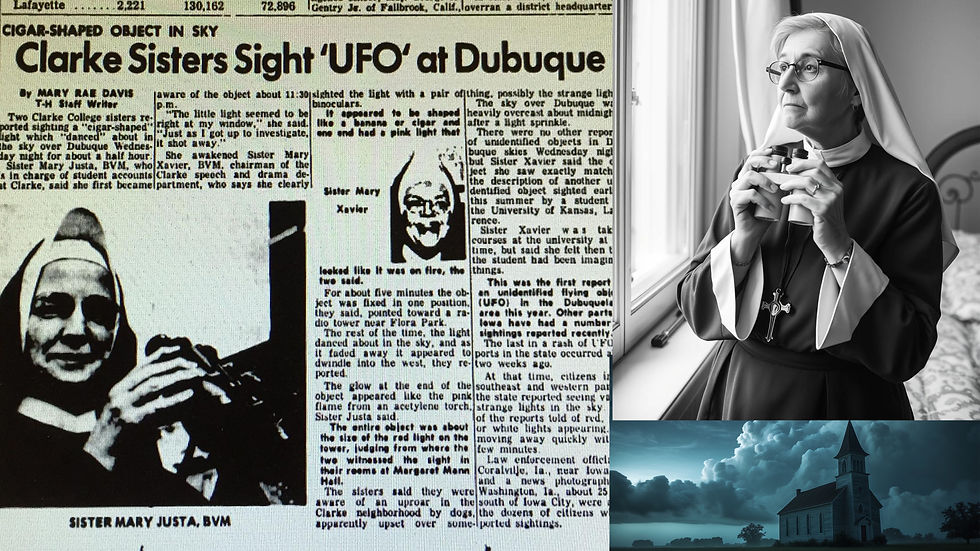They Shot at a UFO. Then 23 Soldiers Turned to STONE in Russia [DECLASSIFIED]
- Cristina Gomez

- Apr 25
- 5 min read
Updated: Jul 25
A declassified CIA document from 2000 details one of the most unusual military encounters ever recorded in official files. This incident, allegedly occurring in Siberia during 1989, describes Soviet military exercises that took a dramatic turn when troops accidentally struck an unidentified flying object with missiles.
According to the document, five humanoid beings emerged from the damaged craft, described as having enlarged cranial features and dark, pronounced eyes. These entities reportedly merged into a single spherical formation, creating an intense light phenomenon accompanied by buzzing and hissing sounds. This sphere expanded dramatically but stopped short of explosion. The document claims this encounter resulted in catastrophic consequences — twenty-three Soviet soldiers were allegedly “petrified instantly, literally transformed into stone-like substances.” Only two soldiers survived, purportedly because they were positioned in a shadowed area during the event. Both the remains of the affected soldiers and the damaged craft were supposedly transported to a secure facility near Moscow for analysis.

The story first gained attention through the Canadian Weekly World News, a publication that has proven difficult to verify. Despite mentions online suggesting this source is known for sensationalism, there appears to be no clear digital presence or official website for this publication, making independent verification challenging. Former CIA operative Mike Baker has raised the possibility that Cold War era files, particularly those concerning military encounters with unexplained phenomena, may have been altered.

This particular report was released through a Freedom of Information Act request in 2011, assigned case number F-2010–00651. The timing of its recent resurgence coincides with increased attention on the UFO phenomenon through the Department of Defense’s UAP Task Force investigations and congressional hearings. Despite the report’s mention on Joe Rogan’s platform in 2023, the information quickly faded from public discourse.
A critical evaluation of this case must acknowledge the complete absence of physical evidence. Despite claims about petrified remains and craft debris being transported to Moscow, no verified samples or photographic evidence has ever emerged. However, the inclusion of this incident in CIA documentation suggests it warranted some level of official attention, regardless of its original source.
UFO Created Panic in Ukraine: The 1982 Nuclear Missile Incident
Russia has documented numerous significant UFO encounters throughout its history, with one particularly alarming case occurring on October 4, 1982, near Usovo, Ukraine. Military personnel stationed at a nuclear missile facility witnessed unidentified lights performing complex aerial maneuvers between 7:30 PM and 9:37 PM. These weren’t mere fleeting glimpses — the objects remained visible for over two hours. Captain Valery Polykhaev described them as “brightly shining objects resembling a New Year’s tree garland” hovering at approximately 5–6 kilometers altitude. Lieutenant Colonel Balanev noted their distinct luminescence ranged from pale yellow to dark cherry colors as they moved through the night sky.
What transformed this from a simple sighting into a major incident was the simultaneous and inexplicable activation of missile launch preparations. For approximately fifteen seconds, control panels at Military Unit 52035 displayed signals indicating missiles were preparing for launch — despite no orders being given and no personnel initiating such protocols. Retired Colonel Boris Sokolov confirmed the signal lights clearly indicated launch preparation sequences had begun autonomously. Major M. Davidovich Kataman observed the spontaneous illumination of all displays at precisely 21:37 hours. One of the most explicit descriptions came from Lieutenant Colonel Vladimir Platunov, who directly referred to the object as “just like a flying saucer” that executed a “beautiful, silent turn” in the sky above the facility.
The Height 611 Incident: Russia’s “Roswell”
What many researchers have dubbed the “Roswell of the Soviet Union” occurred in Dalnegorsk on January 29, 1986, when over twenty witnesses observed a reddish, three-meter diameter sphere crash into Height 611 mountain at 7:55 PM. Unlike typical UFO reports involving distant lights, this object struck the mountain directly, creating an electrical-like fire that burned for hours. Flying noiselessly at 700–800 meters altitude before impact, it left behind substantial physical evidence that challenged scientific explanation. Investigators found a landing site affected by extraordinarily high temperatures, covered with a distinctive black film, and containing numerous anomalous materials — silica rocks with a “smoky” appearance, particles of silvery metal both sprayed across surfaces and in solidified balls, and remarkably thin 17-micrometer “nets” intertwined with gold wires.

The “iron balls” recovered contained an unusual mixture of elements (iron, aluminum, manganese, nickel, chromium, tungsten, and cobalt), while further examination revealed mesh structures resembling glass carbon and materials subjected to temperatures exceeding 2,000°C. For three years following the incident, the site exhibited increased radiation levels, repelled insects, caused electronic equipment to malfunction, and reportedly made some visitors ill. Activity continued when witnesses observed yellowish spheres circling the crash site in February 1986, and later when thirty-two flying objects appeared in November 1987. Scientific teams led by Valeri Dvuzhilni from the Far Eastern Committee for Anomalous Phenomena and V. Skavinsky from the Institute of Geology and Geophysics investigated, with Dvuzhilni proposing it was a malfunctioning alien probe, though debate continues over whether it might have been an unusual meteor.
The Kapustin Yar Files: Secret Base, Secret Encounters
Kapustin Yar, a secretive Russian military installation often compared to America’s Area 51, allegedly housed studies of wreckage from up to eight UFO crashes recovered between 1945–1991. The most significant incident occurred on August 10, 1989, when Soviet radar detected a disc-shaped UFO that was shot down after failed communication attempts. The wreckage, described as a 6.9-meter long, 3.0-meter high “cockleshell” shape, crashed near the Caucasian Mountains with significant radiation detected at the site. Recovery teams reportedly found three non-human entities, each about 1.0–1.2 meters tall, with whitish-gray coverings over blue-green reptilian skin, hairless heads, large black eyes with protective lids, and three-fingered hands. Two were found dead from the crash, while one briefly survived before dying despite medical intervention.

Another notable Kapustin Yar incident occurred on July 28, 1989, when multiple military witnesses observed a phosphorescent green disc hovering over the base around midnight. The 12–15 foot diameter object with a semi-spherical dome emitted a soft glow with minimal heat and remained visible for approximately two hours before rapidly departing when a military aircraft attempted to approach. KGB files supposedly contained handwritten reports from four interrogated witnesses. According to classified reports, the wreckage and biological specimens from the August incident were initially transported to Mozdok Air Base before transfer to Kapustin Yar for study, with the bodies allegedly preserved in special containers near Solnechnogorsk and the craft stored underground west of Ahryomkin.
The Soviet Siberian UFO incident represents a fascinating case study in declassified military documentation. While legitimate questions surround its credibility, it highlights how government agencies monitored and documented unexplained phenomena during the Cold War era, remaining relevant within contemporary discussions of unidentified aerial phenomena.
















Comments